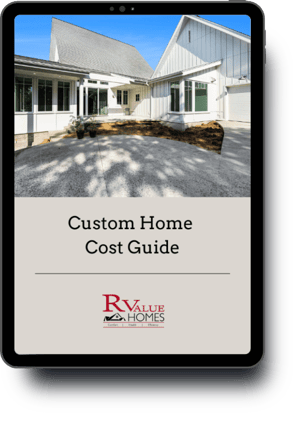5 Min Read
The BEST Way To Be Hands-On In Your Net Zero Home Build
Some people would like to be involved in the construction of their new home beyond just writing a check and picking out colors. If that's you, this is the blog for you.
Maybe you have that can-do attitude that built America that we see all over West Michigan.
You've probably been researching and found there are better ways of doing things. Maybe you even spoken with a few builders and found that many of them are fairly closed-minded to the new ways.
Well today we're going to discuss ways that you can be involved in and have your fingerprints on your home
- Starting with how most builders allow your involvement
- Moving into the ways that we at R-Value Homes involve our clients in every custom home
- Ending with additional ways that you can be involved in the construction of your high-performance home

Typical Builders
There are three basic types of builders.
- Spec home builders
- Semi custom home builders
- Full custom home builders
A spec home is usually going to be on a lot the builder provides. You'll pick out one of maybe four to ten different plans that they offer, and your choices are limited to colors and textures.
With semi custom builders, it's typically going to be built on your land, but you will pick from one of their designs. However, they have more designs available and, will modify them to suit your needs. You'll have greater choice in the selections of materials, but they're still going to be limited to readily available and easily installed materials.
Finally, there's custom home builders. These builders build on your land, design a print unique to your needs, and have an almost unlimited amount of choices that you can make. Of course, most of them will discourage Insulating Concrete Form (ICF) construction because they just don't know enough to be comfortable with it.
R-Value’s Way- Every Home, Every Time
So, how do we involve you in the process of building a home?
Design
First of all, it starts with creating a design. You'll send us some pictures of homes you absolutely love so we can make sure we capture the vibe that you like.
Then we're going to survey your property, figure out the different slopes, what views we want to capitalize on, what views we want to block, and so on.
We'll also discuss things like deciding on a Zero Energy Ready Home certification, ICF walls, type of heating and cooling systems, and many other things that are critical to establish before the design is created.
Pre-Construction
This can be as much or as little as you desire, but during this time we are custom tailoring each specification to your particular home design, and your family’s needs.
It can be a simple rubber stamp on my first draft of the specs, or be an incredibly detailed back and forth conversation.
Some clients are mainly concerned with how the home looks, but they care a LOT about these details; so we can get into the weeds on exterior spigots, which way the soffit runs, corner transitions, etc.
Others view the appearance or their home almost as an afterthought, but would love to dive into the nitty gritty of window glazing and the intricacies of designing a high performance heating and cooling system.
Construction
During construction, we keep you constantly updated with an online job log of what happened on the job site each day. You have 24-7 access to a camera on the site so you can see what's happening at any moment.
We send weekly email of everything that happened that week and what's coming up next.
Monthly progress meetings, whether on-site or on the phone keep you updated and work through any questions that you might have.
Additionally, you have 24-7 access to a project management software where you can go to read the specifications, even reread the conversations that we've had about things like the exterior spigots, and see a basic project schedule.
How Can I Be More Hands-On?
Now let's talk about how else you might be able to be involved if you'd like to.
Research
You probably love research already and that is a great asset.
Dig into what materials you're thinking you'd like to use. Bring that to our attention. Where might we be able to purchase those? What are some best practices you think we should consider? Bring these things as suggestions to us. We're happy to look into them and to consider them.
Keep in mind our experience with Net-Zero homes, ICF homes, and custom home building has been gained through trial and error. We've learned a LOT about what does and doesn't work; but that certainly doesn't mean we know it all.
Project Management
From staking out the house on the property to project final cleanup, there are a lot of tasks you can help with along the way. Most of these are in the realm of project management rather than the trade professional.
Well, what are a few of those?
First is keeping the job site tidy. This can happen on a daily or weekly basis and you would not believe the amount of time and expense that can save you, as well as just general workflow improvement.
Another way is inspecting the deliveries that we receive. Make sure there's no damage. Is everything there that was supposed to be there? That's a huge help to our on-site staff.
You might also decide to protect any of the materials that get delivered or were recently installed.
Another possible way to help is running to get materials. Occasionally the lumber yard forgets something or didn't get it right on their takeoff, and we need a two by twelve and we need it in the next hour! You can run to Grand Rapids and get those materials for us to keep the project going and help out the crew.
These are just more things you can take off our plate. Each one is a way you can save a little bit of money and participate in your home.
Taking on a Scope
A final way you can participate in the construction of your home (admittedly this is a limited way that you can help) is actually performing some of the work, such as installing your own septic system, painting the house, or building your own deck.
The guideline here is that the item needs to be something that is a dead end in the construction sequence, meaning nothing else in the critical path relies on it being done.
We've had some experiences where clients have done siding or built their own doors. While we love the care people put into their home; these are items that need to be done in order for the electrician to finish his work or the trim carpenter to finish his work. And they've often interrupted the progress on site and caused additional costs due to rework requirements. So we advise you not to do those things, look instead for things that don't have any successors to it.
Your Home, Our Expertise
When you build with us, your fingerprints are all over the home, from the design to the details.
- We keep you updated so you never feel out of the loop.
- You can help out on site almost daily if you'd like.
- There are even limited items that you can even self-perform.
We think this is better than DIY, because while building a custom home, ICF home or Net Zero home is a full-time job; building an amazing and high-performance home takes years of research, years of trial and error, and a great deal of skill.
Building a Custom Home in Michigan - The Right Way
R-Value doesn’t build cheap homes, but our TBL2 process helps you prioritize and optimize, so you can spend your precious resources on what matters most to you—whether that is polished concrete floors, radiant heat, or whatever else your heart desires. If you’re in the Greater Grand Rapids area, we would love to build your custom high-performance home. Reach out today and schedule a consultation!




